Research on a Ship Deflection Anti-Collision Method Based on a Water-Jet Interference Flow Field
Abstract
:1. Introduction
2. Generalized Model Experiments
2.1. Project Overview
2.2. Generalized Model Test Scale
2.3. Model Design
2.4. Test Model
2.5. Test Conditions
2.6. Numerical Simulation
2.7. Overset Grid Technology
2.8. Renormalization Group (RNG) k-ε Turbulence Model
2.9. Numerical Simulation Pre-Processing
2.10. Grid-Independence and Time-Independence Verification
2.11. Boundary Conditions and Meshing
3. Comparative Studies
3.1. Comparison of Ship Deflection Effects
3.2. Tracks Line
3.2.1. Model Test Tracks Line
3.2.2. Model Experiments and Numerical Simulation of the Trace Line Comparison
3.3. Maximum Drift Angle of the Ship
3.4. Generalized Model Test
3.5. Comparison of Maximum Drift Angle between the Model Test and Numerical Simulation
3.6. Yaw Moment
4. Results and Simulation
- Stage 1: The ship is close to the interference zone and influenced by the difference of the velocity and negative pressure zone in the boundary layer of the interference zone, resulting in a negative yaw moment in the clockwise direction and a small deflection of the ship toward the nozzle of the water-jet generator as shown in Figure 24a, Figure 25a and Figure 26a, respectively.
- Stage 2: The stage where the deflection force of the ship away from the pier is generated. At this stage, the ship is subjected to the interference zone to generate a positive yaw moment in the counterclockwise direction, the yaw moment from the negative peak rapidly increases, and the ship deflects away from the pier as shown in Figure 24b, Figure 25b and Figure 26b, respectively.
- Stage 3: In the supplementary stage of the deflection force of the ship away from the pier, the ship is affected by the interference zone and the inertia of the second stage, and the overall hull drifts away from the pier. During this process, the ship’s yaw moment reaches a positive peak and then decreases rapidly as shown in Figure 24c, Figure 25c and Figure 26c, respectively.
- Stage 4: In this stage of the ship attitude’s adjustment, affected by the energy attenuation of the interference zone, the difference in the deflection moment between the yaw and stern makes the ship’s drift angle decrease, and its course gradually returns to normal. At this time, the ship has moved away from the pier as shown in Figure 24d, Figure 25d and Figure 26d, respectively.
5. Conclusions
6. Patents
Author Contributions
Funding
Institutional Review Board Statement
Informed Consent Statement
Data Availability Statement
Conflicts of Interest
References
- Perera, L.P.; Soares, C.G. Striking risk detection and quantification in ship navigation with integrated bridge systems. Ocean Eng. 2005, 109, 344–354. [Google Scholar] [CrossRef]
- Manen, S.E.; Frandsen, A.G. Ship collision with bridges, review of accidents. In Ship Striking Analysis; Gluver, H., Olsen, D., Eds.; Balkema: Rotterdam, The Netherlands, 1998; pp. 3–11. [Google Scholar]
- Larsen, O.D. Ship Collision with Bridges, the Interaction between Vessel Traffic and Bridge Structures; IABSE: Zuerich, Switzerland, 1993. [Google Scholar]
- Jiang, H.; Chorzepa, M.G. Case Study: Evaluation of a Floating Steel Fender System for Bridge Pier Protection against Vessel Collision. J. Bridge Eng. 2016, 21, 05016008. [Google Scholar] [CrossRef]
- Yu, G.; Gan, W. Study on the probability model of ship-bridge collision. IOP Conf. Series Earth Environ. Sci. 2021, 783, 012157. [Google Scholar] [CrossRef]
- Shen, Z. A review of the research progress of bridge anti-ship collision measures. Transp. Sci. Technol. 2015, 270, 73–76. [Google Scholar]
- Simonsen, B.C.; Ottesen-Hansen, N. Protection of Marine Structures by Artificial Islands. In Ship Collision Analysis—Proceedings of the International Symposium on Advances in Ship Collision Analysis, Copenhagen, Denmark, 10–13 May 1998; Routledge: London, UK, 1998; pp. 201–215. [Google Scholar]
- Svensson, H. Protection of bridge piers against ship collision. Steel Constr. 2009, 2, 21–32. [Google Scholar] [CrossRef]
- Li, R. Analysis of the current situation of the research on the main collision prevention measures of bridges. Sichuan Cem. 2021, 294, 242–243. [Google Scholar]
- AASHTO. Guide Specifications and Commentary for Vessel Collision Design of Highway Bridges, 2nd ed.; AASHTO: Washington, DC, USA, 2009. [Google Scholar]
- Zhou, L.; Li, H.; Wei, J.; Pu, X.; Mahunon, A.D.; Jiang, L. Design and simulation analysis of a new type of assembled UHPC collision avoidance. Appl. Sci. 2020, 10, 4555. [Google Scholar] [CrossRef]
- Liu, B.; Yang, S.; Li, W.; Zhang, M. Damping dissipation properties of rubberized concrete and its application in anti-collision of bridge piers. Constr. Build. Mater. 2020, 236, 117286. [Google Scholar] [CrossRef]
- Voyiadjis, G.Z.; El-Tawil, S.; Kocke, P.J. Feasibility of Tubular Fender Units for Pier Protection against Vessel Collision; Louisiana Transportation Research Center: Baton Rouge, LA, USA, 2008. Available online: https://rosap.ntl.bts.gov/view/dot/22324 (accessed on 1 August 2008).
- Hollaway, L.C. A review of the present and future utilisation of FRP composites in the civil infrastructure with reference to their important in-service properties. Constr. Build Mater 2010, 24, 2419–2445. [Google Scholar] [CrossRef]
- Fang, H.; Sun, H.; Liu, W.; Wang, L.; Bai, Y.; Hui, D. Mechanical performance of innovative GFRP-bamboo-wood sandwich beams: Experimental and modelling investigation. Compos. B Eng. 2015, 79, 182–196. [Google Scholar] [CrossRef]
- Bakis, C.E.; Bank Lawrence, C.; Brown, V.L.; Cosenza, E.; Davalos, J.F.; Lesko, J.J.; Machida, A.; Rizkalla, S.H.; Triantafillou, T.C. Fiber reinforced polymer composites for Construction—State-of-the-Art review. J. Compos. Construct. 2002, 6, 73–87. [Google Scholar] [CrossRef] [Green Version]
- Kafodya, I.; Xian, G.; Li, H. Durability study of pultruded CFRP plates immersed in water and seawater under sustained bending: Water uptake and effects on the mechanical properties. Compos. B Eng. 2015, 70, 138–148. [Google Scholar] [CrossRef]
- Sha, Y.; Hao, H. Laboratory tests and numerical simulations of CFRP strengthened RC pier subjected to barge impact load. Int. J. Struct. Stab. Dyn. 2015, 15, 1450037. [Google Scholar] [CrossRef]
- Jiang, P.-F.; Wang, P.-F.; Cao, H.-F.; Wang, F. Research on new flexible bridge pier anti-collision technology. IOP Conf. Ser. Earth Environ. Sci. 2020, 565, 012091. [Google Scholar] [CrossRef]
- Zhu, L.; Liu, W.; Fang, H.; Chen, J.; Zhuang, Y.; Han, J. Design and simulation of innovative foam-filled Lattice Composite Bumper System for bridge protection in ship collision. Compos. B. Eng. 2019, 157, 24–35. [Google Scholar] [CrossRef]
- Sanna, A.; Lamberti, F. Advances in target detection and tracking in Forward-Looking InfraRed (FLIR) imagery. Sensors 2014, 14, 20297–20303. [Google Scholar] [CrossRef] [Green Version]
- Wang, S.; Ren, H.; Yun, X.; Yan, X.-F.; Dan, D.-H. Active anti-collision system for navigable bridges and its performance analysis. China J. Highw. 2012, 25, 94–100. [Google Scholar]
- Hu, C.; Cui, W. A review of ship collision mechanism and crashworthy structure design. Ship Mech. 2005, 2, 131–142. [Google Scholar]
- Du, D. Study on the bridge-waters area ship safety collision avoidance navigation system. In Proceedings of the 2018 Chinese Control And Decision Conference (CCDC), Shenyang, China, 9–11 June 2018; pp. 3603–3606. [Google Scholar] [CrossRef]
- Mao, D. Research on the Effect of Anti-Ship Collision Device on Ship Navigation in Mountainous Curved River Section. Master’s Thesis, Chongqing Jiaotong University, Chongqing, China, 2021. [Google Scholar]
- Raven, H.C. Shallow-water effects in ship model testing and at full scale. Ocean Eng. 2021, 189, 106343. [Google Scholar] [CrossRef]
- Yao, J. Numerical Study on Bank Effects for a Ship Sailing along a Bank. Master’s Thesis, Shanghai Jiaotong University, Shanghai, China, 2010. [Google Scholar]
- Tan, Z.; Wang, Y.; Wang, H.; Wang, Z.; Chen, B. Quantitative analysis of the effect of bridge pier turbulence on ship bow rocking moment. J. Wuhan Univ. Technol. 2022, 46, 371–376. [Google Scholar]
- Razgallah, I.; Kaidi, S.; Smaoui, H.; Sergent, P. The impact of free surface modelling on hydrodynamic forces for ship navigating in inland waterways: Water depth, drift angle, and ship speed effect. J. Mar. Sci. Technol. 2019, 24, 620–641. [Google Scholar] [CrossRef]
- Chan, W.M. Overset grid technology development at NASA Ames Research Center. Comput. Fluids 2009, 38, 496–503. [Google Scholar] [CrossRef]
- Salim, S.M.; Buccolieri, R.; Chan, A.; Di Sabatino, S. Numerical simulation of atmospheric pollutant dispersion in an urban street canyon: Comparison between RANS and LES. J. Wind Eng. Ind. Aerodyn. 2011, 99, 103–113. [Google Scholar] [CrossRef]
- Shen, Z. Numerical Method Study of Overlapping Mesh Technique for Ship Paddle-Rudder Interaction. Ph.D. Thesis, Shanghai Jiaotong University, Shanghai, China, 2014. [Google Scholar]
- van Hooff, T.; Blocken, B.; Tominaga, Y. On the accuracy of CFD simulations of cross-ventilation flows for a generic isolated building: Comparison of RANS, LES and experiments. Build. Environ. 2017, 114, 148–165. [Google Scholar] [CrossRef]
- Wang, J.; Wan, D.-C. Numerical simulation of pure rocking head motion of a ship based on overlapping mesh technique. Hydrodynam. Res. Prog. 2016, 31, 567–574. [Google Scholar]
- Shi, Z.; Jin, S. Numerical Investigation of Hydrodynamics in a U-Shaped Open Channel Confluence Flow with Partially Emergent Rigid Vegetation. Water 2022, 14, 4027. [Google Scholar] [CrossRef]
- Yu, S.; Dai, H.; Zhai, Y.; Liu, M.; Huai, W. A Comparative Study on 2D CFD Simulation of Flow Structure in an Open Channel with an Emerged Vegetation Patch Based on Different RANS Turbulence Models. Water 2022, 14, 2873. [Google Scholar] [CrossRef]
- Yakhot, V.; Smith, L.M. The renormalization group, the ɛ-expansion and derivation of turbulence models. J. Sci. Comput. 1992, 7, 35–61. [Google Scholar] [CrossRef]
- Yakhot, V.; Orszag, S.A.; Thangam, S.; Gatski, T.B.; Speziale, C.G. Development of turbulence models for shear flows by a double expansion technique. Phys. Fluids A Fluid Dyn. 1992, 4, 1510–1520. [Google Scholar] [CrossRef] [Green Version]
- Sun, Y. Ship Maneuverability; Harbin Engineering University Press: Harbin, China, 2019. [Google Scholar]
- Ke, X. Study on the Impact of Water Flow Navigation in the Bridge Section of the Navigation Channel. Master’s Thesis, Southeast University, Chongqing, China, 2019. [Google Scholar]
- Qian, D. Study on the Interaction Mechanism between Water Flow Structure around Bridge Piers and Ships. Master’s Thesis, Changsha University of Technology, Changsha, China, 2013. [Google Scholar]
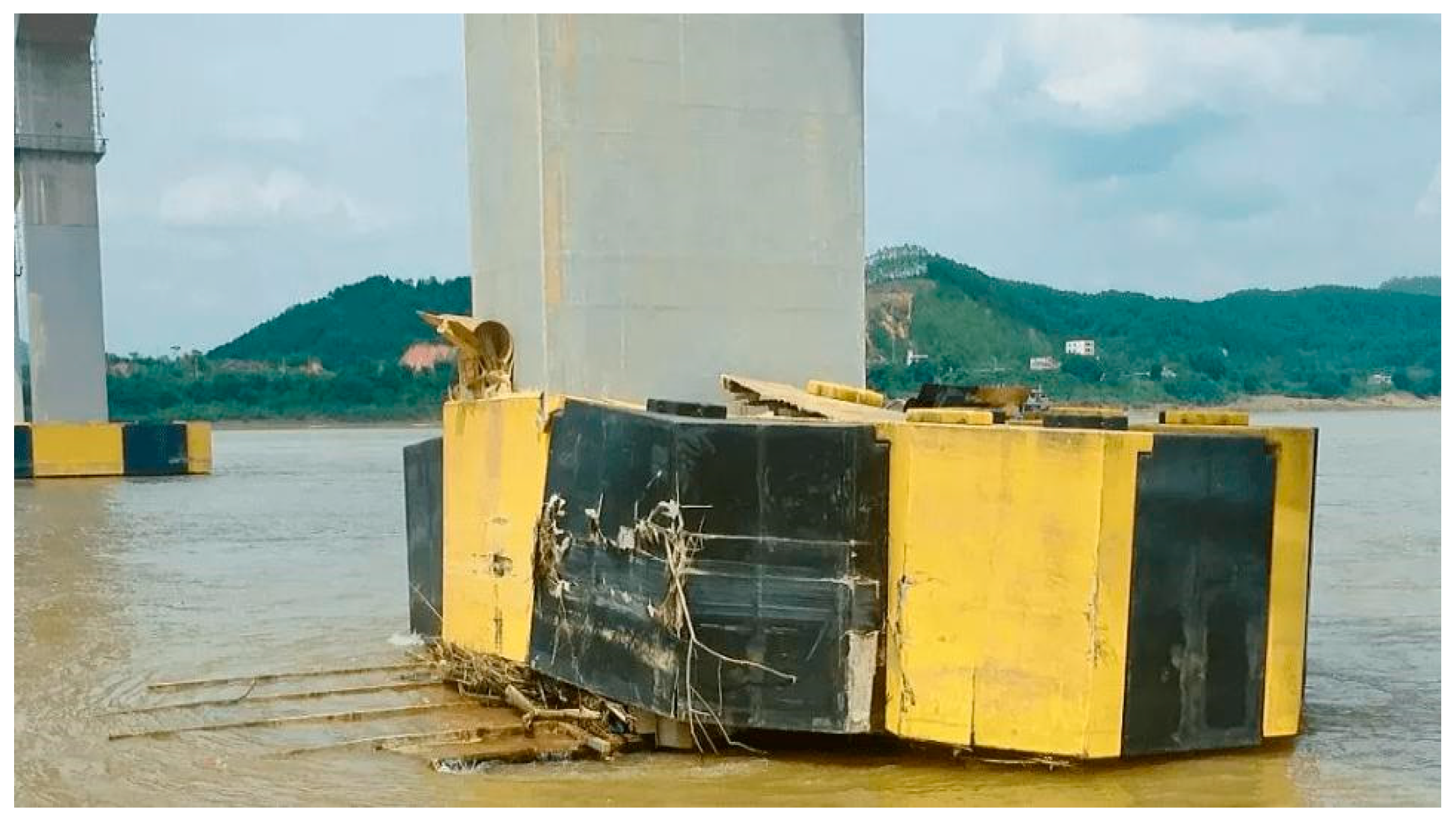
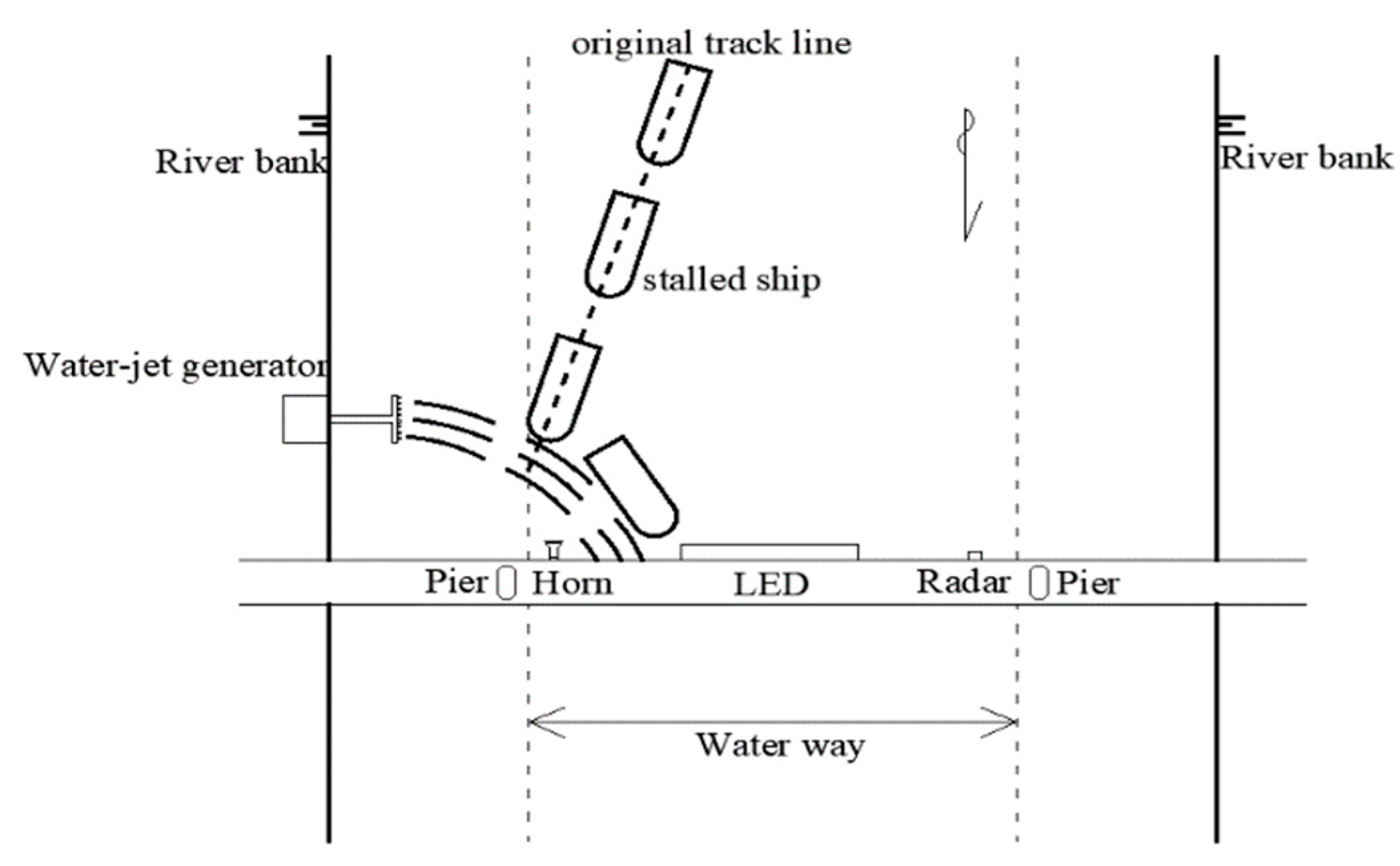



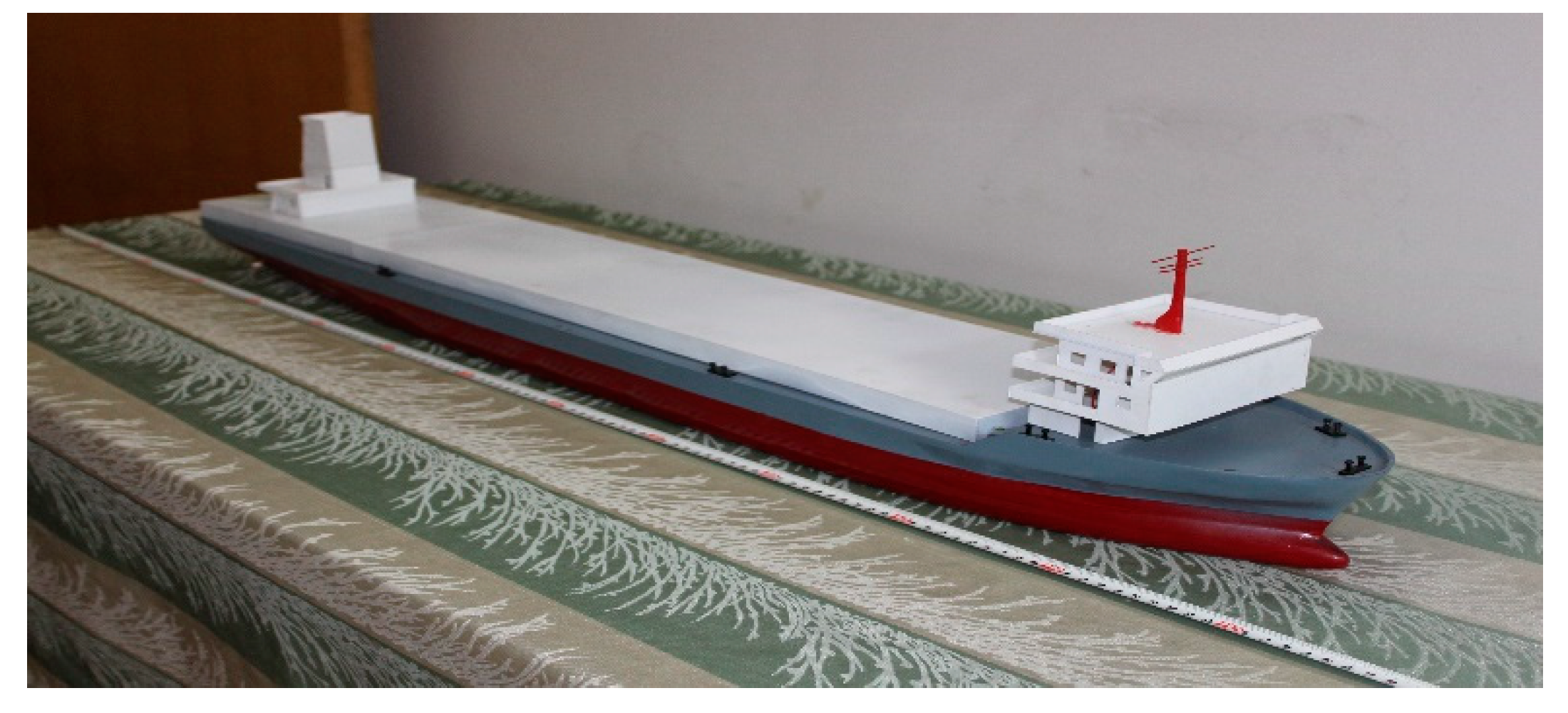
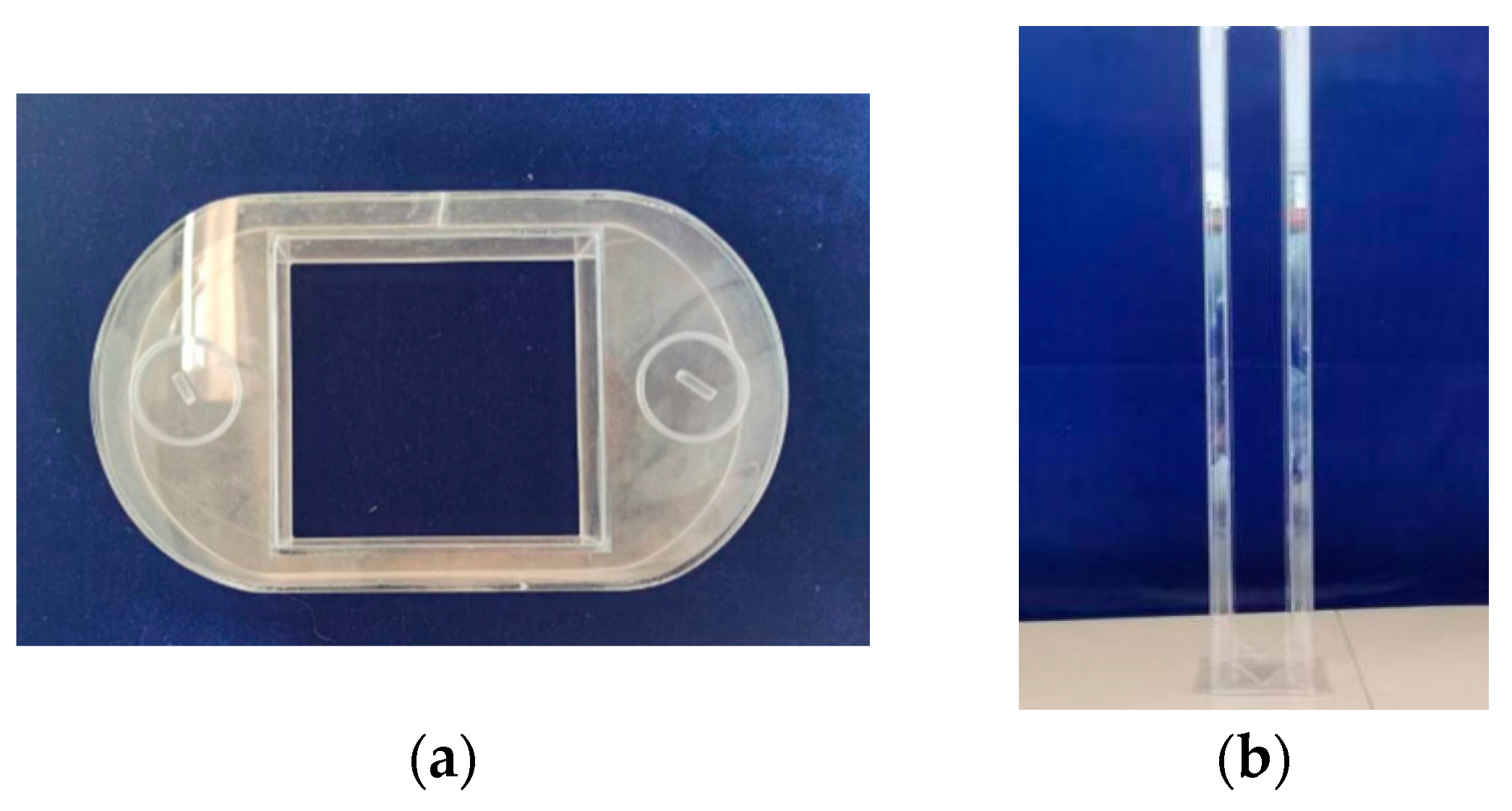


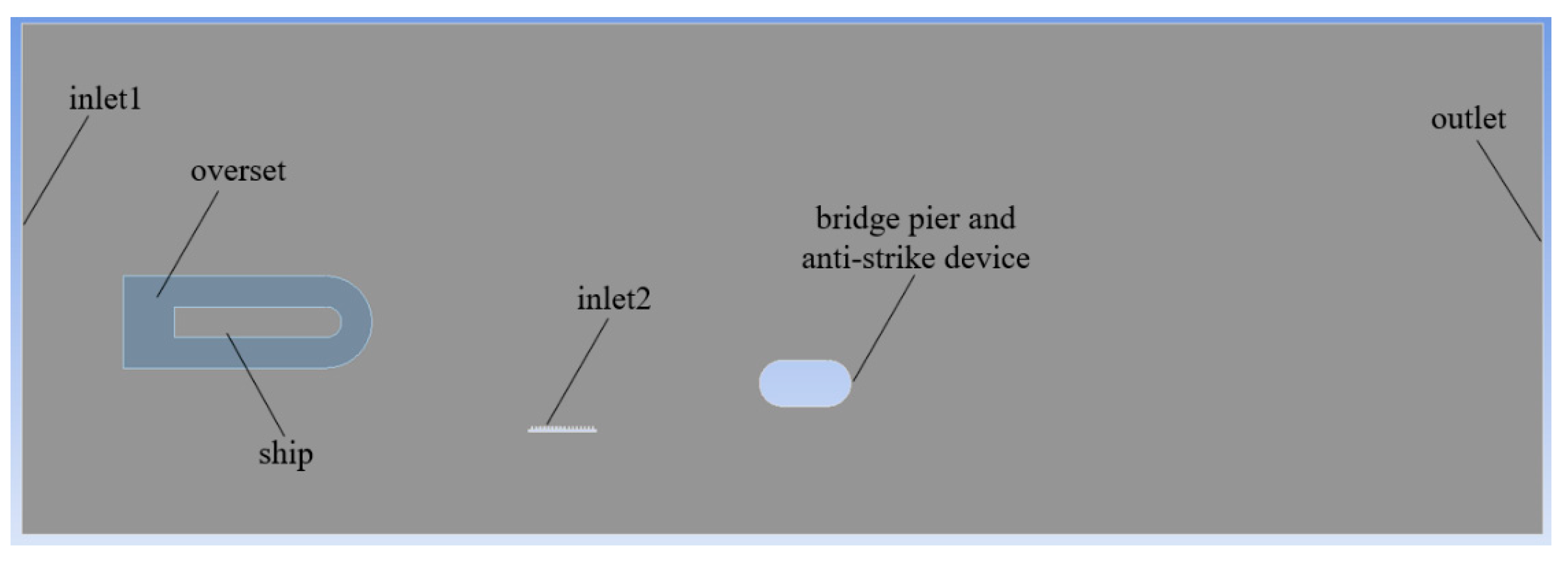


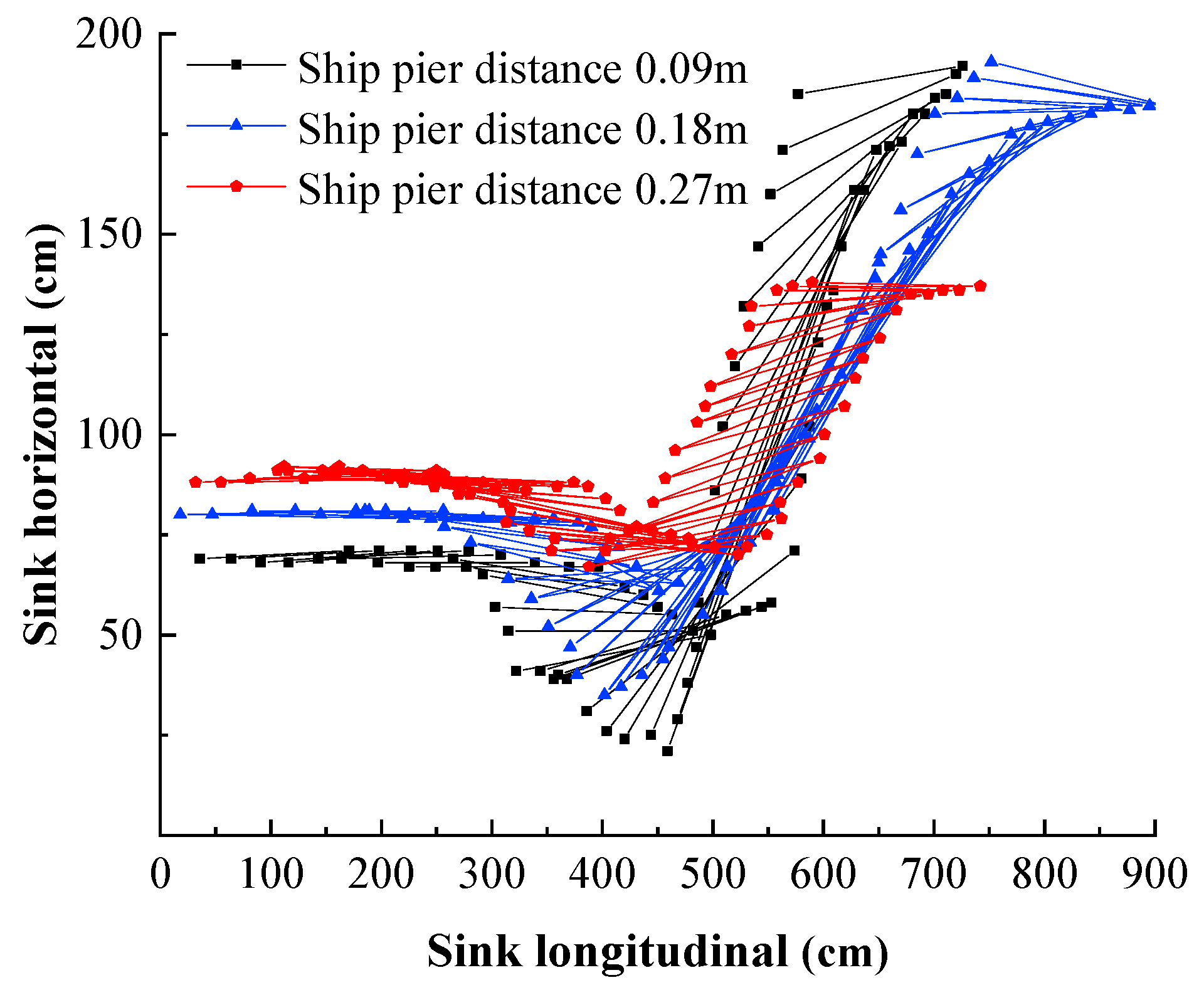
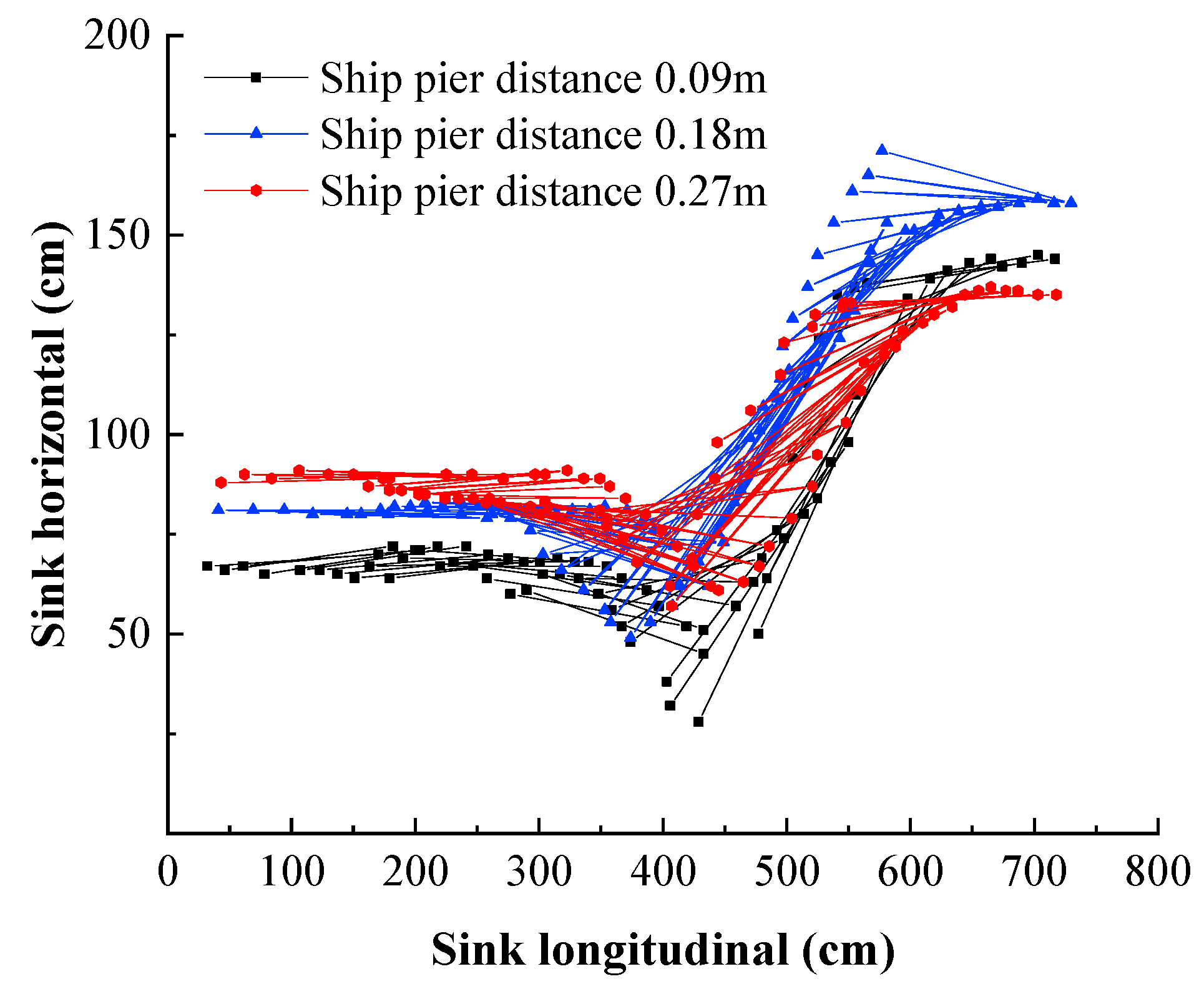
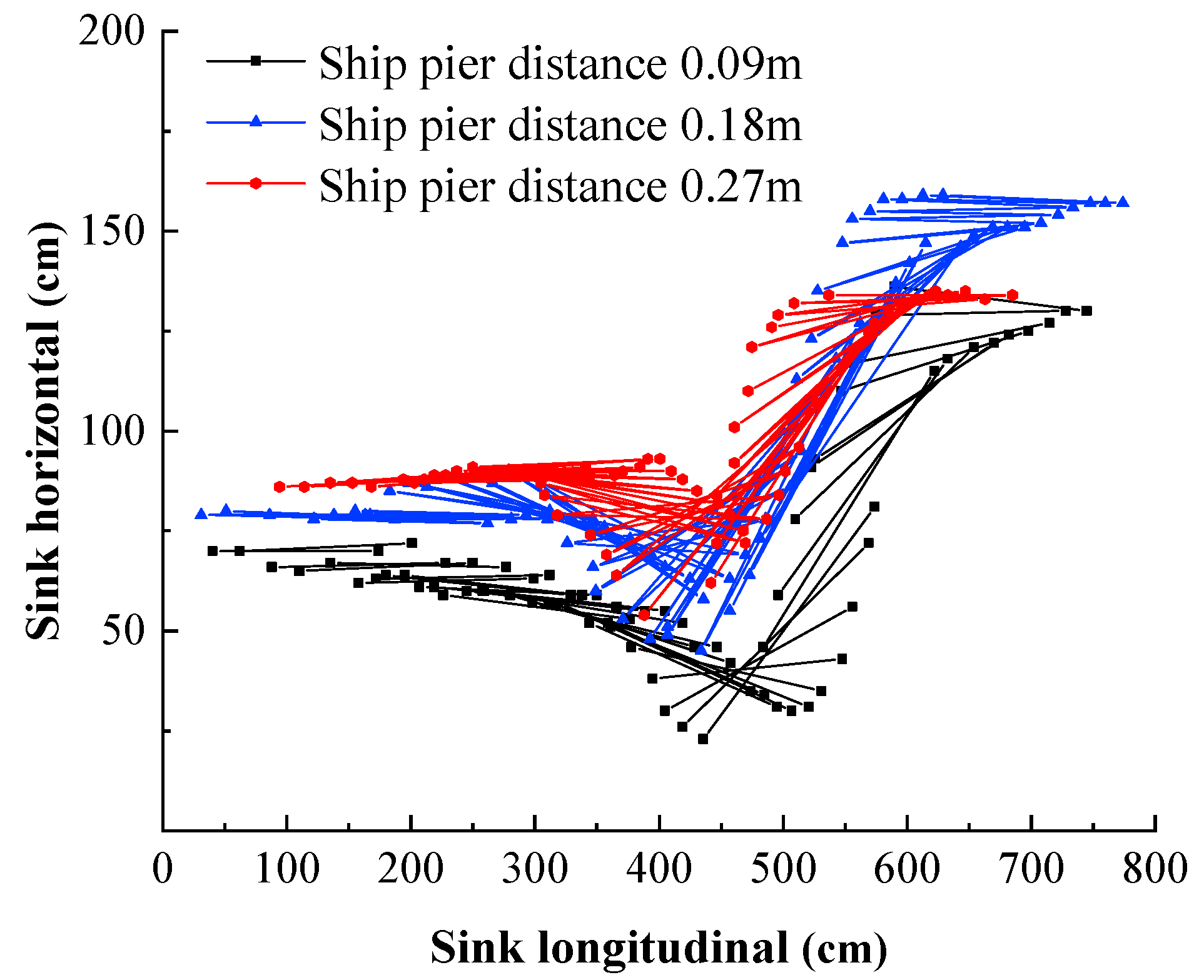
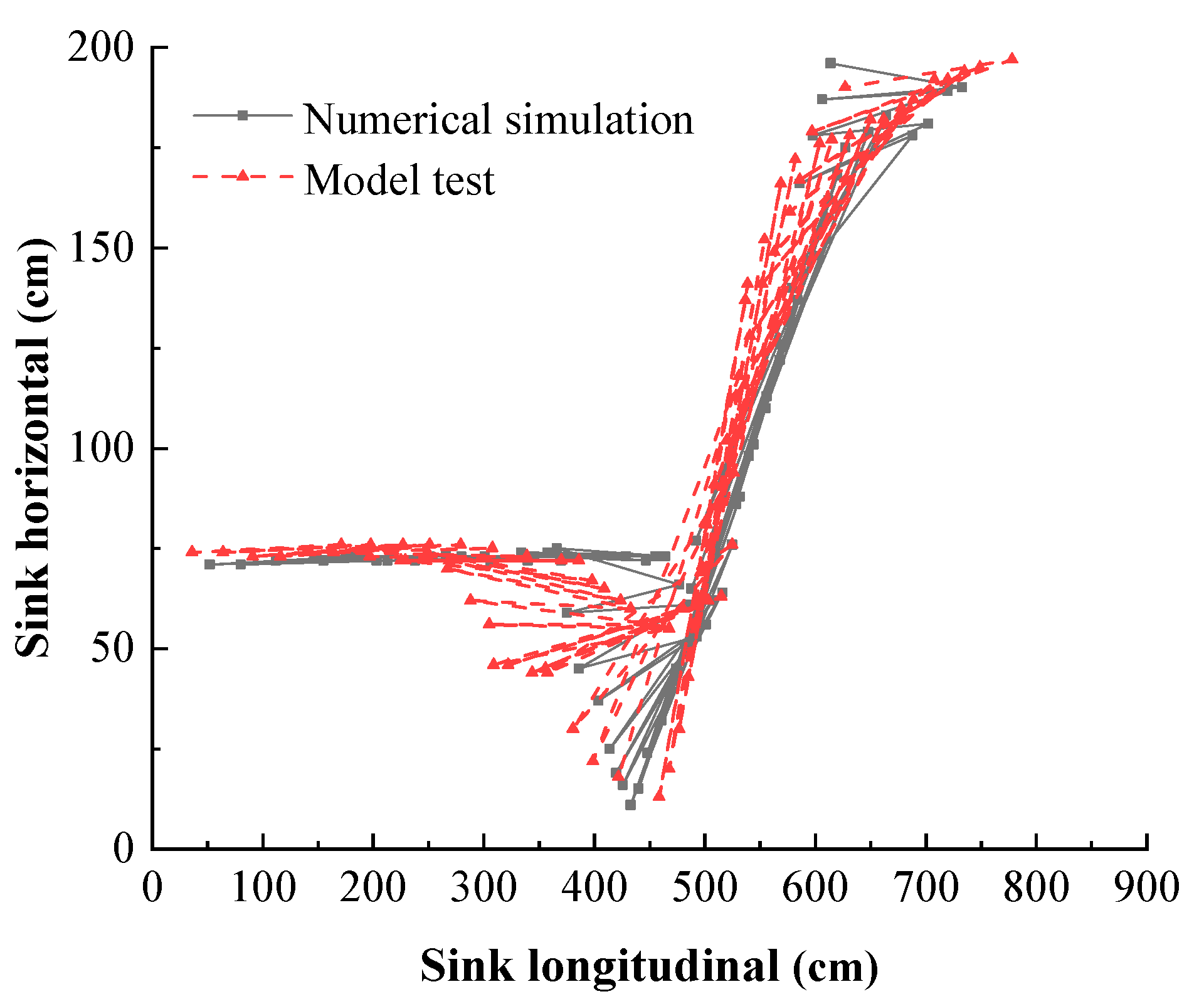

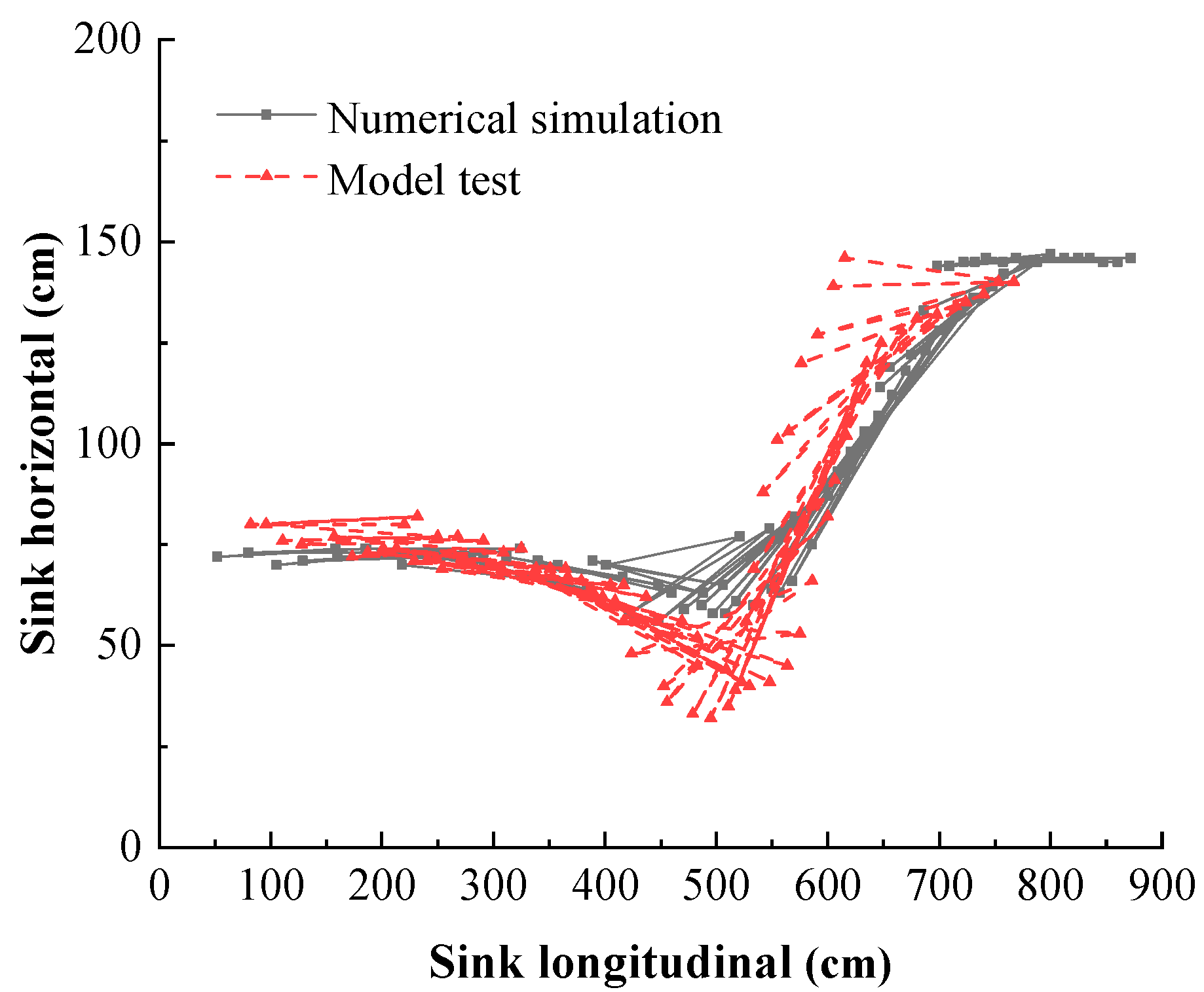
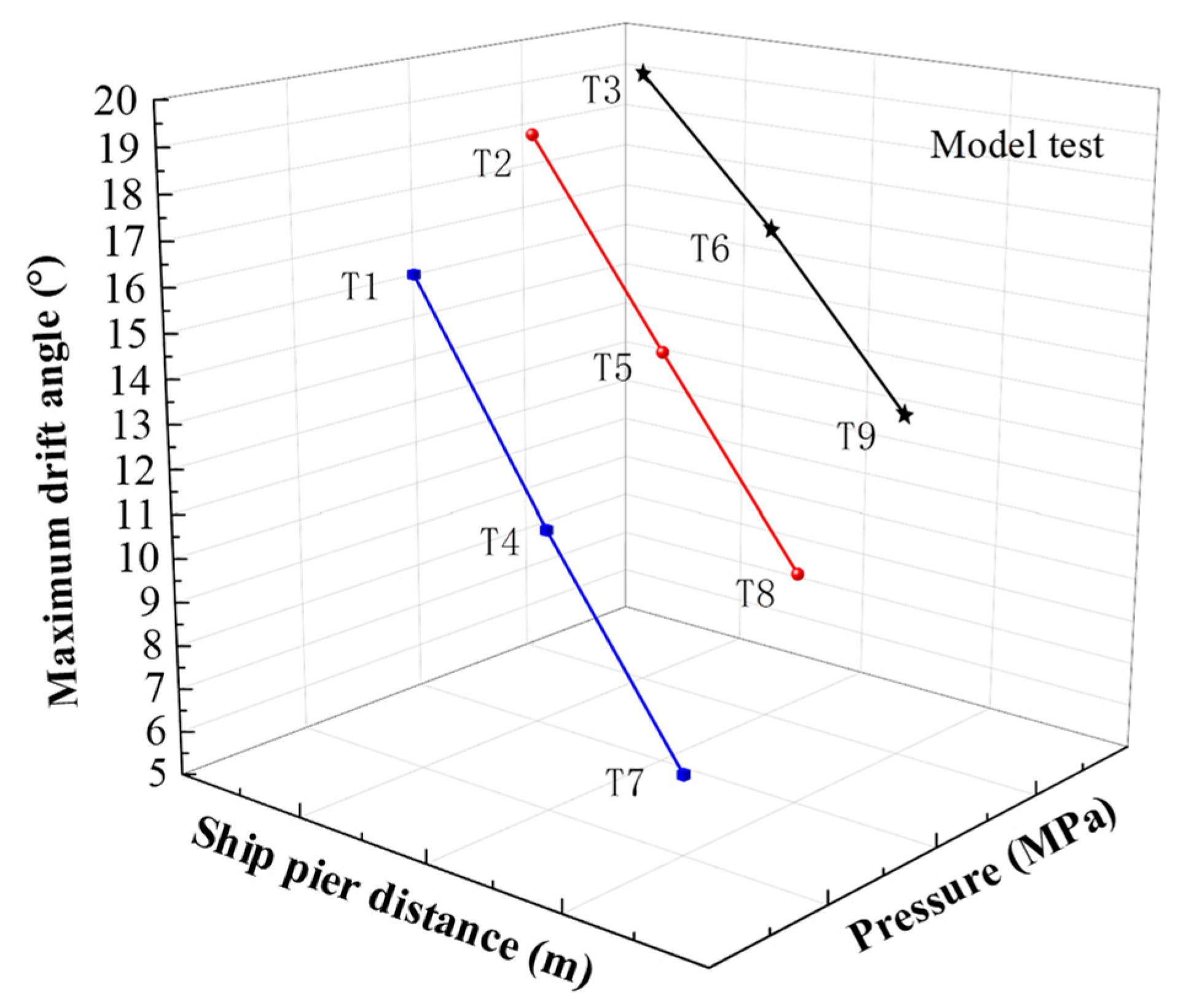
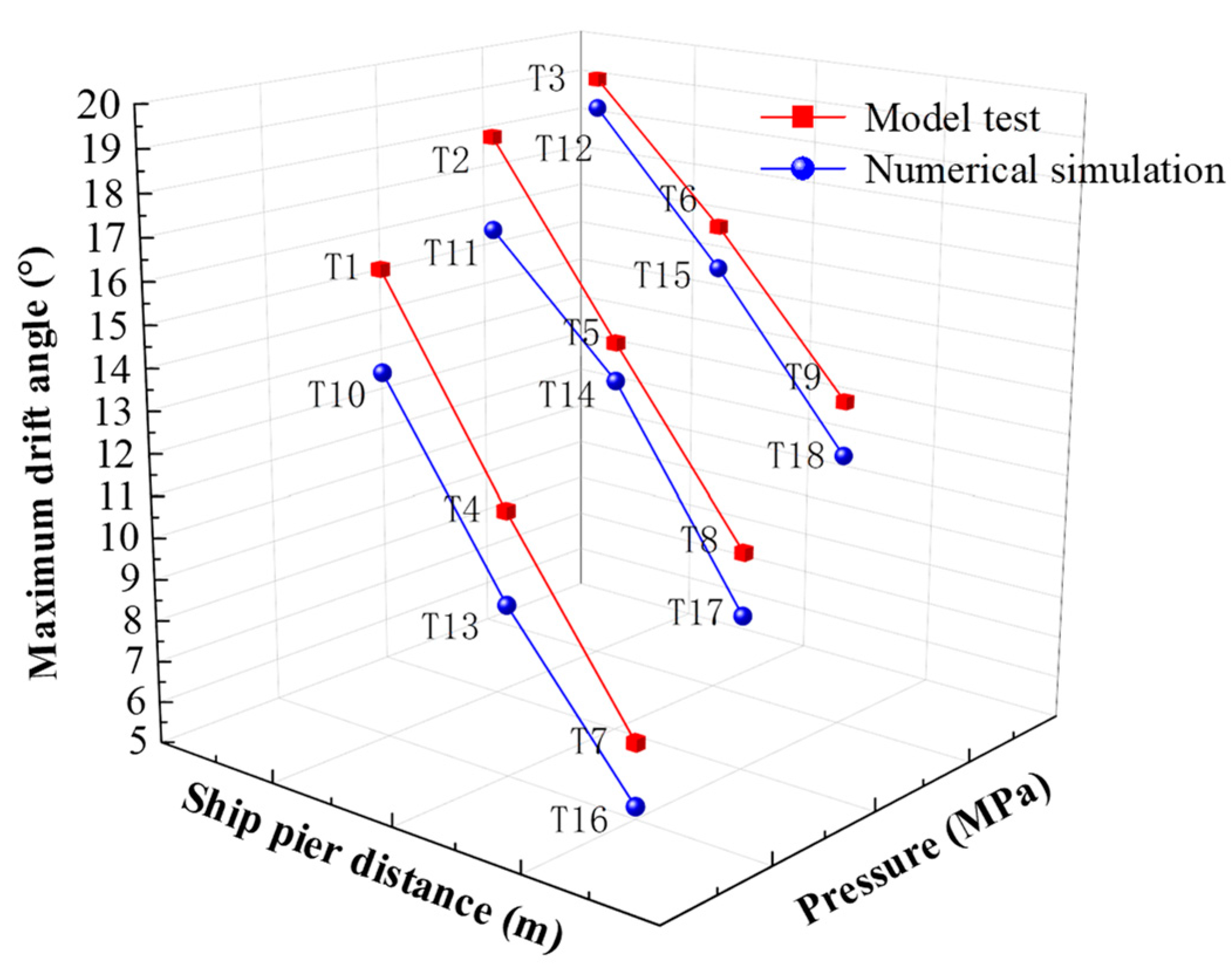
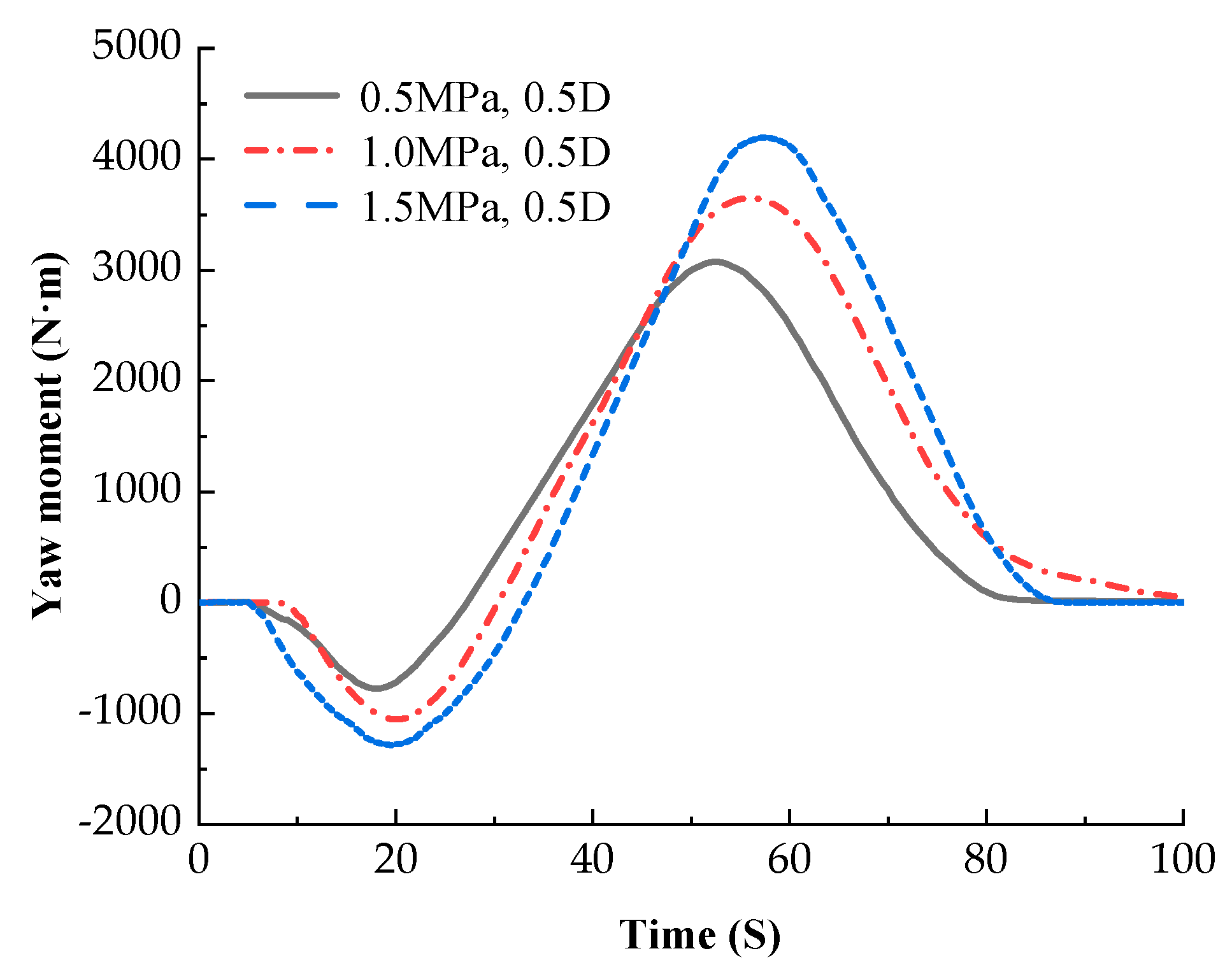

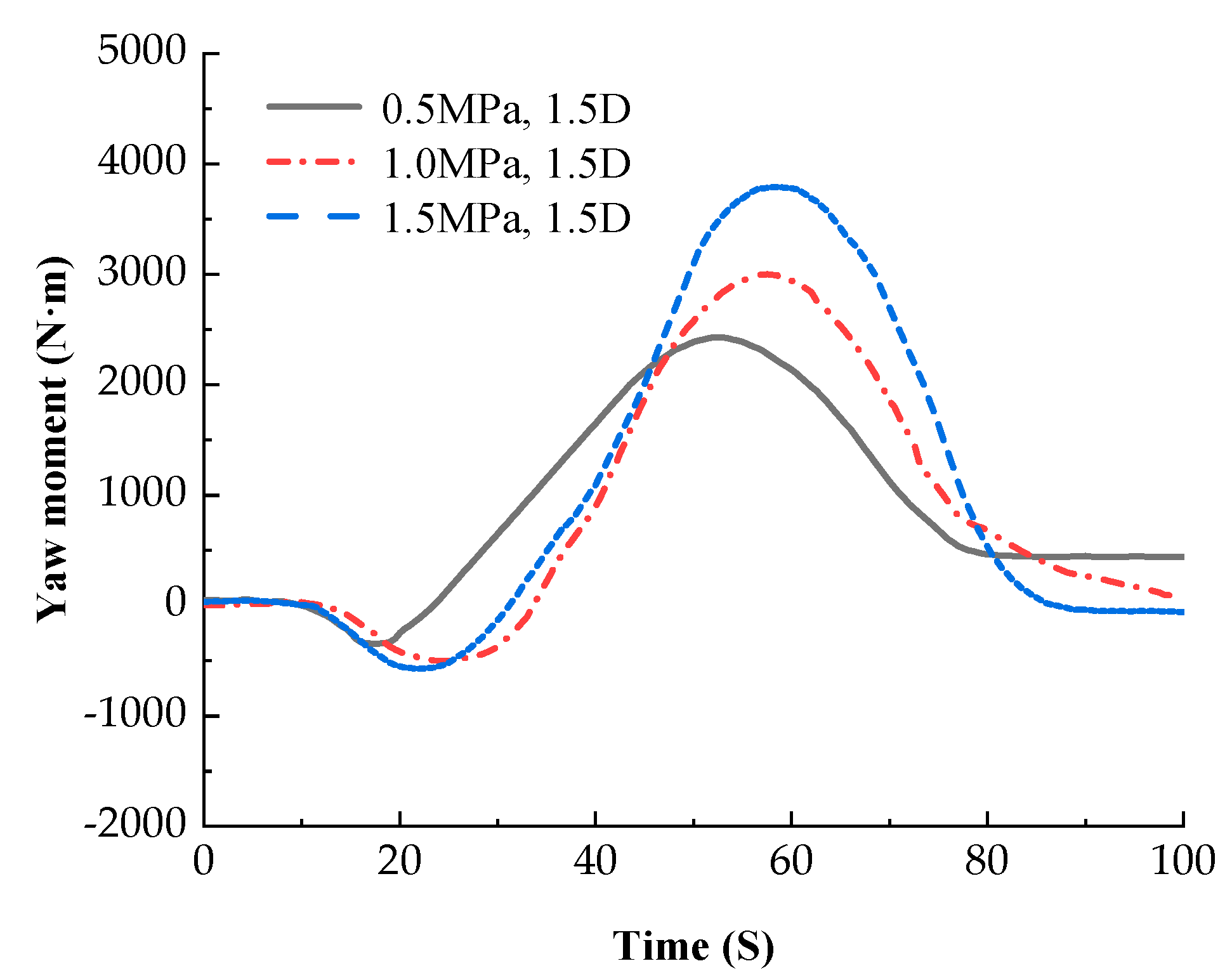
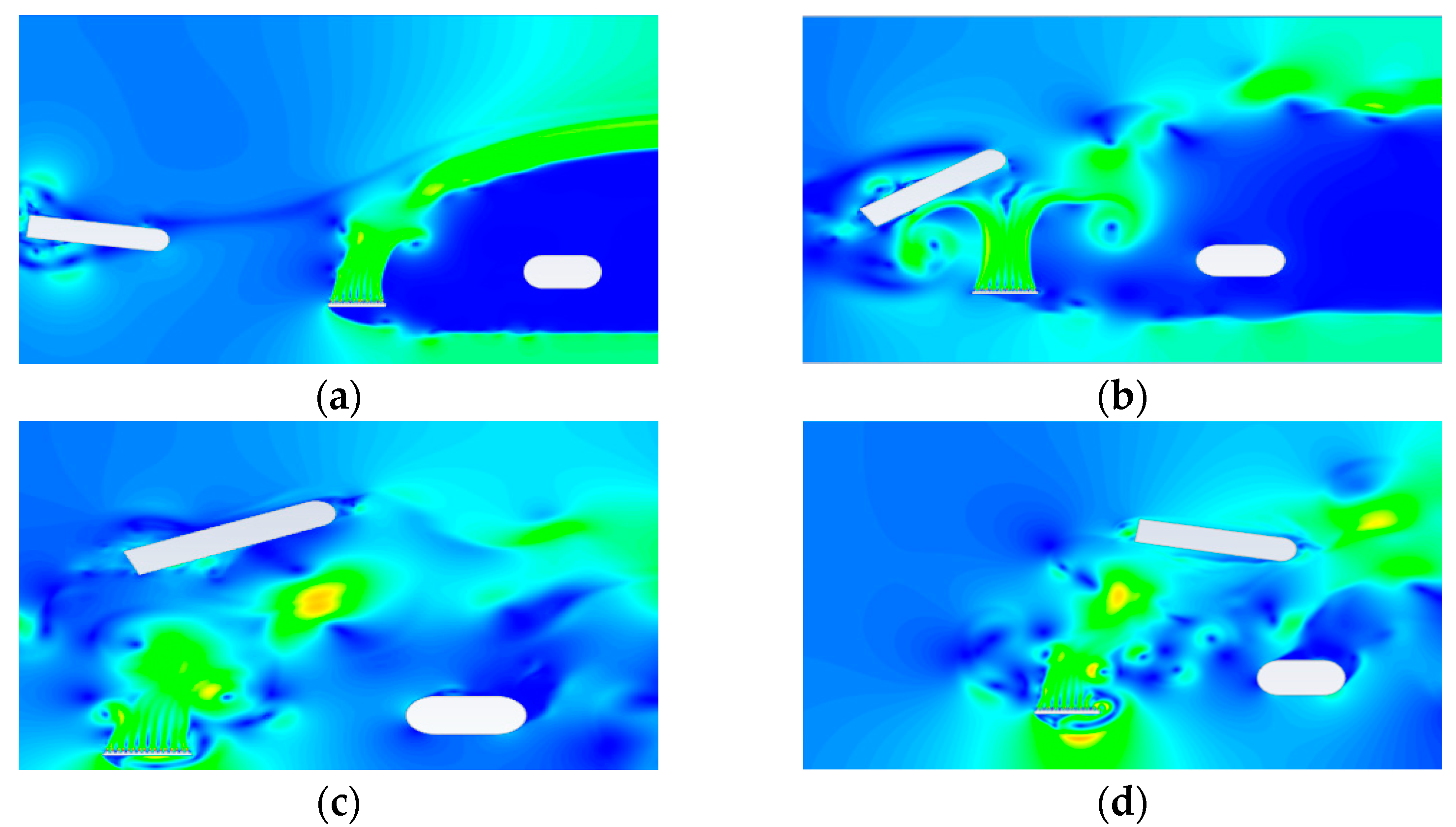


| Item | Geometric Scale | Flow Rate Scale | Pressure Scale |
|---|---|---|---|
| Scale | 100 | 10 | 100 |
| Calculation basis |
| Project | Prototype Flow | Test Sink Flow | Prototype Water Velocity | Test Water Velocity |
|---|---|---|---|---|
| Data | 1.93–2.73 m/s |
| Ship Pier Distance | Water-Jet Generator Nozzle Pressure | ||
|---|---|---|---|
| 0.005 MPa | 0.010 MPa | 0.015 MPa | |
| 0.5 D | T1 | T2 | T3 |
| 1.0 D | T4 | T5 | T6 |
| 1.5 D | T7 | T8 | T9 |
| Ship Pier Distance | Water-Jet Generator Nozzle Pressure | ||
|---|---|---|---|
| 0.5 MPa | 1.0 MPa | 1.5 MPa | |
| 0.5 D | T10 | T11 | T12 |
| 1.0 D | T13 | T14 | T15 |
| 1.5 D | T16 | T17 | T18 |
| Parameter | Value | Parameter | Value |
|---|---|---|---|
| Length (m) | 64.5 | Izz () | |
| Width (m) | 12 | Load displacement (kg) |
Disclaimer/Publisher’s Note: The statements, opinions and data contained in all publications are solely those of the individual author(s) and contributor(s) and not of MDPI and/or the editor(s). MDPI and/or the editor(s) disclaim responsibility for any injury to people or property resulting from any ideas, methods, instructions or products referred to in the content. |
© 2023 by the authors. Licensee MDPI, Basel, Switzerland. This article is an open access article distributed under the terms and conditions of the Creative Commons Attribution (CC BY) license (https://creativecommons.org/licenses/by/4.0/).
Share and Cite
Yu, K.; Wang, H.; Liu, X.; Peng, B. Research on a Ship Deflection Anti-Collision Method Based on a Water-Jet Interference Flow Field. Appl. Sci. 2023, 13, 7354. https://doi.org/10.3390/app13137354
Yu K, Wang H, Liu X, Peng B. Research on a Ship Deflection Anti-Collision Method Based on a Water-Jet Interference Flow Field. Applied Sciences. 2023; 13(13):7354. https://doi.org/10.3390/app13137354
Chicago/Turabian StyleYu, Kui, Hongming Wang, Xianqing Liu, and Bingli Peng. 2023. "Research on a Ship Deflection Anti-Collision Method Based on a Water-Jet Interference Flow Field" Applied Sciences 13, no. 13: 7354. https://doi.org/10.3390/app13137354






